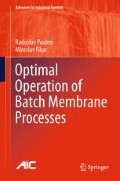Abstract
In this chapter we derive necessary conditions for optimality (NCO) that can identify candidates for a solution of an OCP. We introduce analytical methods of solving the OCPs. Next, we discuss how gradients to optimisation criterion w.r.t. optimisation variables can be gathered. These represent a key issue in solving the OCP numerically. We present a few most popular numerical methods used to solve the problem of optimal control. We also discuss closed-loop implementation, handling of disturbances and nonlinear state-feedback control.
Access this chapter
Tax calculation will be finalised at checkout
Purchases are for personal use only
Notes
- 1.
For further explanation see [16].
- 2.
In this case, an \(\ell _1\) norm is used in the objective and the controls are restricted to not change a sign.
References
Alstad V, Skogestad S, Hori ES (2009) Optimal measurement combinations as controlled variables. J Process Contr 19:128–148
Bellman R (1957) Dynamic Programming. Princeton University Press
Biegler LT (1984) Solution of dynamic optimization problems by successive quadratic programming and orthogonal collocation. Comput Chem Eng 8(3/4):243–248
Bock HG, Plitt KJ (1984) A multiple shooting algorithm for direct solution of optimal control problems. Proceedings 9th IFAC World Congress Budapest XLI I(2):243–247
Brusch RG, Schappelle RH (1973) Solution of highly constrained optimal control problems using nonlinear programming. AIAA J 11(2):135–136
Bryson, Jr AE, Ho YC (1975) Applied Optimal Control. Hemisphere Publishing Corporation
Camacho EF, Bordons C (1999) Model Predictive Control. Springer-Verlag, London
Chang FR (2004) Stochastic Optimization in Continuous Time. Cambridge University Press
Čižniar M, Salhi D, Fikar M, Latifi MA (2005) A MATLAB package for orthogonal collocations on finite elements in dynamic optimisation. In: Mikleš J, Dvoran J, Fikar M (eds) Proceedings of the 15th Int. Conference Process Control ’05, Štrbské Pleso, June 7–10, 2005, Slovakia, 058f.pdf
Feehery WF (1998) Dynamic optimization with path constraints. PhD thesis, Massachusetts Institute of Technology
Fleming WH, Rishel RW (1975) Deterministic And Stochastic Optimal Control. Springer Verlag
Goh CJ, Teo KL (1988) Control parameterization: A unified approach to optimal control problems with general constraints. Automatica 24(1):3–18
Grancharova A, Johansen TA (2012) Explicit Nonlinear Model Predictive Control. No. 429 in Lecture Notes in Control and Information Sciences, Springer Verlag
Hirmajer T, Fikar M (2007) Open loop optimal control of a hybrid system. Selected Topics in Modelling and Control 5:45–51
Hirmajer T, Čižniar M, Fikar M, Balsa-Canto E, Banga JR (2008) Brief introduction to DOTcvp–dynamic optimization toolbox. In: Proceedings of the 8th International Scientific–Technical Conference Process Control 2008, Kouty nad Desnou, Czech Republic
Hull DG (2003) Optimal Control Theory for Applications. Springer-Verlag New York, Mechanical Engineering Series
Kouvaritakis B, Cannon M (eds) (2001) Non-linear Predictive Control: Theory and Practice. The Institution of Engineering and Technology, London
Kvasnica M (2009) Real-Time Model Predictive Control via Multi-Parametric Programming: Theory and Tools. VDM Verlag, Saarbruecken
Maciejowski JM (2002) Predictive Control with Constraints. Prentice Hall, London
Pontryagin LS, Boltyanskii VG, Gamkrelidze RV, Mishchenko EF (1962) The Mathematical Theory of Optimal Processes. John Wiley & Sons Inc, New York
Rawlings JB, Mayne DQ (2009) Model Predictive Control: Theory and Design. Nob Hill
Rosen O, Luus R (1991) Evaluation of gradients for piecewise constant optimal control. Comput Chem Eng 15(4):273–281
Rossiter JA (2003) Model-Based Predictive Control: A Practical Approach. CRC Press Inc
Skogestad S (2004) Near-optimal operation by self-optimizing control: From process control to marathon running and business systems. Comput Chem Eng 29(1):127–137
Srinivasan B, Bonvin D (2004) Dynamic Optimization under Uncertainty via NCO Tracking: A Solution Model Approach. In: BatchPro Symposium, pp 17–35
Srinivasan B, Bonvin D, Visser E, Palanki S (2003a) Dynamic Optimization of Batch Processes: I. Characterization of the Nominal Solution. Comput Chem Eng 27:1–26
Srinivasan B, Bonvin D, Visser E, Palanki S (2003b) Dynamic Optimization of Batch Processes: II. Role of Measurements in Handling Uncertainty. Comput Chem Eng 27:27–44
Srinivasan B, Palanki S, Bonvin D (2003c) Dynamic optimization of batch processes: I. Characterization of the nominal solution. Comput Chem Eng 27(1):1–26
Tsang TH, Himmelblau DM, Edgar TF (1975) Optimal control via collocation and nonlinear programming. Int J Control 21(5):763–768
Author information
Authors and Affiliations
Corresponding author
Rights and permissions
Copyright information
© 2016 Springer International Publishing Switzerland
About this chapter
Cite this chapter
Paulen, R., Fikar, M. (2016). Solution of Optimal Control Problems. In: Optimal Operation of Batch Membrane Processes. Advances in Industrial Control. Springer, Cham. https://doi.org/10.1007/978-3-319-20475-8_3
Download citation
DOI: https://doi.org/10.1007/978-3-319-20475-8_3
Published:
Publisher Name: Springer, Cham
Print ISBN: 978-3-319-20474-1
Online ISBN: 978-3-319-20475-8
eBook Packages: EngineeringEngineering (R0)

